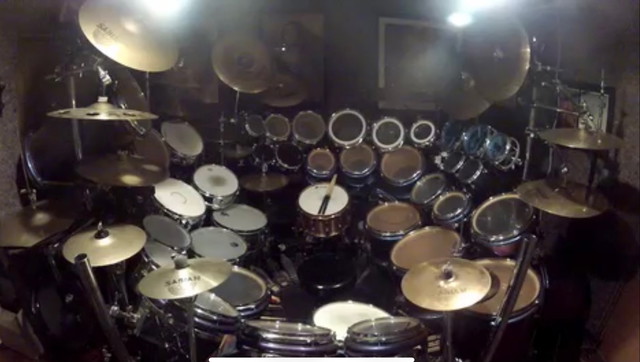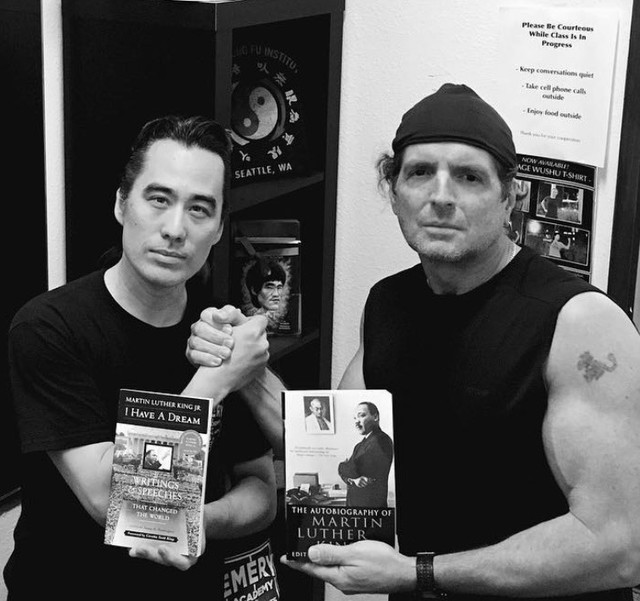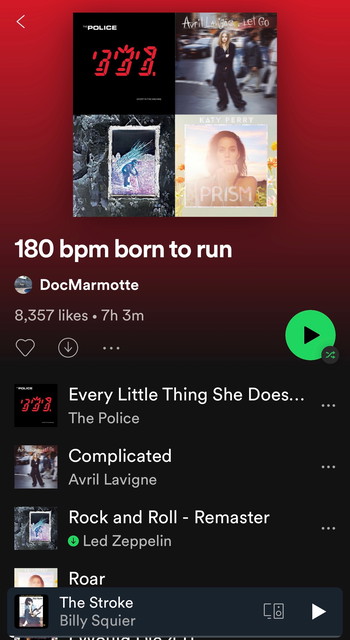The Bobby Rock Newsletter #34 (11-18-2021) - The Drum Vid Vault... Revealed!
The Bobby Rock Newsletter #34 (11-18-2021) - The Drum Vid Vault... Revealed!
What’s up, gang?
This week, I introduce the Drum Vid Vault… my private, ever-expanding collection of drum vids that, until now, has largely been kept out of public view. If this sounds inconsequential, I get it. And yet, any time we go from private to public with anything in our creative life, it’s significant to the creator. So, I appreciate the platform here, friends.
We also have a couple other (hopefully) useful tidbits this week, as well. Let’s get it on!
In this Issue:
- Everyday Martial Arts Wisdom for All: The often-unappreciated art of diffusing verbal conflict with the same eloquence that we diffuse potential physical conflict.
- Hot Tip: "Reps and Steps" in Rhythm: Here’s a cool tool for increasing speed and stamina in your training (or practice time).
- Vid from the Vault: At long last… the process of posting lots of playing vids of my "Alpha Kit” has begun, along with a commitment to post more drumming vids in general, more consistently.

The early days of the Alpha Kit
_______________
The (Martial) Art of Diffusing Conflict
A surprising, yet prominent, paradox at the heart of any martial arts system I've ever studied is this: we are taught to do almost anything to avoid a fight. This might seem counterintuitive at first because, after all, if we are studying and practicing the art of fighting, shouldn’t we look to “scrap it out” with someone who’s provoking us?
Actually… no. The common directive is usually something like, “We learn how to fight so we don’t have to fight.” And there is a litany of sound reasons why this is the unspoken credo of pretty much any traditional martial arts practice.
But beyond the obvious wisdom in this directive, there is also a more philosophical reason to avoid a fight at all cost: there are likely deeper issues going on with the person who is looking to fight you, and it is incumbent on the “more sane person in the moment” to diffuse the situation. Therefore, in such a scenario, we must step up and be the more sane… for the benefit of all involved.
And yet, why don’t we apply this beautiful logic to our non-physical scenarios? Why is it so admirable for the bad-ass martial artist to walk away from the big-mouthed agitator guy who’s asking for it—and who the martial artist could easily dispense with—but it is often viewed as so “pansy-assed” for us to walk away or disengage from a verbal confrontation with someone, like an exceedingly rude service provider or clerk, or even an emotionally jacked-up friend, colleague, or loved one? “Don't let them speak to you like that!” is often the sentiment, along with a general sense that we are being disrespected or devalued and, therefore, we need to “stand up for ourselves.”
Again, none of those considerations factor into how or why we will avoid the physical fight. And yet, they are often at the heart of why we will happily carry on in a verbal exchange.
My point:
While it might behoove us on occasion to engage in spirited dialogue, in almost every instance where someone is being unreasonably combative, it’s a sure sign that all is not right with them in the moment. They are angry, hurt, frustrated, depleted, or experiencing something (as we've discussed) in the realm of the "unseen." They are, temporarily, not fully themselves, not fully of sound mind. What they really need is a moment of reset, decompression, or self-reflection… essentially a touch of energetic space where they can return to a more even-keeled emotional baseline. How can that best be facilitated? By “the more sane” in the moment going neutral and allowing them a bit of that space. And in the spirit of martial arts, I feel that we, my friends, must always strive to be the most sane in any such trying situation.
And remember, no one does their best thinking or reasoning when they are upset… and this includes us! Science has shown that we are literally utilizing a different part of our brain (the fight or flight “lizard brain" part) on such occasions and this will always cause us to say stupid, regrettable shit. So I say, let’s try to spare ourselves having to offer up another lame apology in the aftermath of such an exchange and, instead, go neutral… diffuse… disarm... just as that master martial artist might do in a de-escalation situation of the physical variety.
This, of course, is a disciplined, higher-minded aspiration that takes practice and patience—just like any other worthwhile endeavor in life.
Ode to a Master

Speaking of master martial artists, here’s a quick shout-out to my long-time friend and teacher, Sifu Matt Emery (Emery Academy of Martial Arts). Here's someone who exudes that peaceful, positive, light energy of a true master, along with extraordinary skills in the fighting arts that are absolutely breathtaking. This pic of us from Matt’s b-day a few years ago has always been a personal fave. I had just gifted him a couple MLK books (he’s also a huge fan) after one of our training sessions and… well... the pic is worth a thousand words, I suppose. (We even had Mr. Lee in the background!) Love you, brother…
_______________
"Reps and Steps" in Rhythm
Looking to increase speed and stamina in your activity of choice? Consider using a BPM (beats per minute) model with music for some of your training or practice time. Here’s the quick overview:
The tempo of a song is ultimately determined by how many "beats per minute” it has. So for a slow song, you might tap your foot 70 times a minute; a mid-tempo track might be 110 times; and something “up tempo” might be around 180. These numbers represent the song's BPM.
This approach is about spending some of your training/practice time performing your “reps or steps” in tempo to a playlist where the songs reflect an optimal BPM for your current goals. This works great for runners and walkers because, once you figure out your optimal pace for the type of training day it is, you can simply create a playlist of songs that represent that BPM, then “step” in time to the music.
For me, 180 BPM is a good “race pace.” That tempo causes me to execute my strides quicker, but a bit shorter and more efficient. So I have playlists where I literally plot out my entire workout: a few songs to warm up where I’m not really paying attention to BPMs; then maybe 40 or 50 minutes worth of tunes at 180 so I can grind it out; and then a final few random tracks just to mark the time for cool down. (That would be a workout I might do once a week on what we call a “tempo” run… but I wouldn’t do that every run!) So if you are a runner or walker, see what pace works for you, then put together your own custom playlist.
Finding the Tracks
Surprisingly, a simple Google search—or a basic search in your music library of choice—will typically yield dozens of examples of tunes in a particular BPM range. As an example, here’s a random Spotify playlist on 180:

From there, just compile at will. And remember, you can build multiple lists at various BPMs for all types of training (slower BPM for a longer run/walk, etc.).
“Reps" instead of “Steps”
If running or walking isn’t your thing, no worries: This concept works beautifully for all kinds of training and practicing ideas.
For other cardio work like cycling, elliptical, rowing machine, etc., just count reps instead of steps.
For martial arts-style training, your reps could be about certain punching or kicking sequences, in rhythm, performed for the duration of a song. (Tougher than it sounds… especially if the tempo is brisk!)
For higher-rep resistance training movements (pushups, crunches, light dumbbell work), the same thing applies. Keep those reps cranking in tempo!
For musicians, find that challenging tempo for that particular riff or exercise you’re looking to master, and use the tempo and duration of the song as a guide to not only mark the optimal tempo to practice the riff, but also to improve your stamina.
Important Note: Remember, no matter how you may utilize this idea, it’s not always about having to keep it going for the duration of the song. In fact, with regard to sprinting and also practicing certain drum riffs, I will intentionally choose a BPM track that’s beyond my current capability to maintain for the entire song, and then take short 15 to 20 second recovery breaks along the way, as needed. From there, I will work on shortening the breaks over time, until I can maintain the pace for the entire track without stopping. (It's always a great day when this happens!) The key? Relaxed intensity: The idea of remaining as relaxed as possible and not allowing the muscles to tighten up too much as you maintain the brisker speeds.
Enjoy the burn!
_______________
Introducing: The Drum Vid Vault
I have a sizable collection of personal drumming video clips that I’ve amassed through the years, mainly for my own documentation and reference. There are a fair amount of live clips, but tons more from the practice room… which means they feature the “Alphabet Kit,” or Alpha Kit, for short. This is my 40-piece monstrosity of a drum set which, stunningly, I’ve failed to publicly document video footage of on any level over the past 12 or so years... except for a single clip I spontaneously threw out there earlier this year on MLK’s b-day, since it was a clip of me “dryping” (drumming + typing) part of his “I Have a Dream” speech. Sure, I’ve posted pics and updates about the kit from time to time, and I wrote extensively about its genesis in my 2015 book, Zentauria. But why I have largely kept this part of my drumming life a private matter, I’m not sure, to be honest.
Nonetheless, it appears that all of the prodding I’ve received from my inner circle peeps about this through the years—along with an unexpected personal epiphany I had about the issue just this week—has prompted me to do things differently moving forward.
Which brings us to this moment of introduction.
The Drum Vid Vault videos run the gamut, but most are either about evaluating and/or archiving some idea I’ve been working on, or trying a little free form improv where I’m looking to utilize certain concepts or techniques. To kick things off, I thought I would go back to the early days of the Alpha kit for Page One of the Vault. This vid is so old, that 1) I hadn’t even started to use those alphabet decals on the heads yet; 2) this was the original set-up of the kit which has since been altered, and 3) you can really see how far tech has come in terms of sound and vid quality! But here is a 90-second excerpt of a larger clip where I was just jamming around.

In vid 2 below it, there’s a quick tour of this earlier version of the kit so you can see the set-up a bit more clearly. (December 2012!) I don’t know who the fuck (if anyone) I was filming this tour for… it’s almost like a time capsule vid or something.
There’s also a few more pics and vids on the page that document the evolution of the kit. Enjoy… and look for much more to come as we start filling up the Vault:
Scope it HERE.
Scope the MLK alphabet drumming clip HERE.
_______________
Thanks again, friends! Connect next week...
Until then,
BR
_______________
|
For Your Quick Reference:
My main website at www.bobbyrock.com is constantly updated with cool new stuff. Be sure and take a moment to sign up in the upper right-hand corner of any page on the site. It only takes a minute. This will give you a much more customized experience, and also grant you access to various members-only areas, events, etc. Tour Dates: If you are signed up to the site, you will receive an automatic email notification any time I'm playing within 150 miles of your crib. Newsletter Archives: Scope all the back issues here. There is even a Table of Contents reference so you grab an "at-a-glance" view of what's in each issue. News Feed: Stay in touch! Think of this as Facebook and Instagram rolled into one location, plus extra posts exclusive to the site. The Bobby Rock Store: Books, Music, BR drumsticks (stage-played and brand new), T-shirts, Signed 8x10s, Dragon Dirt and more... Dragon Dirt: My brand new custom superfood powder. Scope the site for tons of info! |

